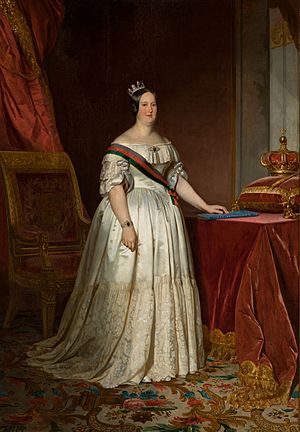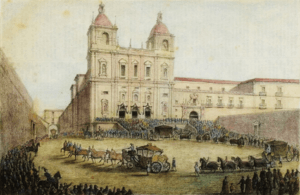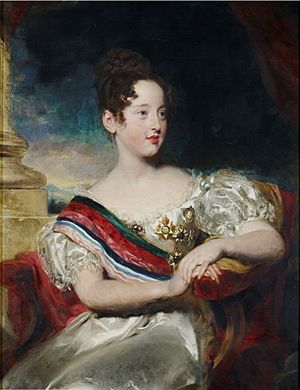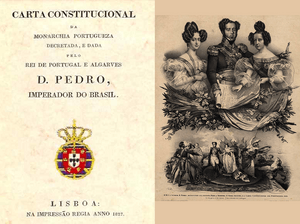Maria II of Portugal facts for kids
Quick facts for kids Maria II |
|||||
|---|---|---|---|---|---|

Portrait by Ferdinand Krumholz in 1846
|
|||||
| Queen of Portugal | |||||
| Reign | 26 May 1834 – 15 November 1853 | ||||
| Acclamation | 20 September 1834 | ||||
| Predecessor | Miguel I | ||||
| Successor | Pedro V | ||||
| Co-monarch | Ferdinand II | ||||
| Regent | Pedro IV (1834) | ||||
| Prime Ministers |
See list
|
||||
| Reign | 2 May 1826 – 23 June 1828 | ||||
| Predecessor | Pedro IV | ||||
| Successor | Miguel I | ||||
| Regents |
See list
|
||||
| Born | 4 April 1819 Palace of São Cristóvão, Rio de Janeiro, Kingdom of Brazil |
||||
| Died | 15 November 1853 (aged 34) Necessidades Palace, Lisbon, Kingdom of Portugal |
||||
| Burial | Pantheon of the Braganzas, Lisbon, Portugal | ||||
| Spouses |
|
||||
| Issue among others... |
|
||||
|
|||||
| House | Braganza | ||||
| Father | Pedro IV of Portugal | ||||
| Mother | Maria Leopoldina of Austria | ||||
| Religion | Roman Catholicism | ||||
| Signature | |||||
Dona Maria II (born April 4, 1819 – died November 15, 1853) was known as "the Educator" or "the Good Mother." She reigned as Queen of Portugal from 1826 to 1828, and again from 1834 to 1853. Maria was born in Rio de Janeiro, Brazil. She was the first child of Emperor Pedro I of Brazil and Empress Maria Leopoldina. Maria was a member of the House of Braganza, a famous royal family. She was the only European monarch born outside Europe.
Contents
Maria's Early Life
Born in Brazil
Maria II was born on April 4, 1819, at the Palace of São Cristóvão in Rio de Janeiro. Her full name was Maria da Glória Joana Carlota Leopoldina da Cruz Francisca Xavier de Paula Isidora Micaela Gabriela Rafaela Gonzaga. Her father was Prince Pedro de Alcântara, who later became King of Portugal (Pedro IV) and the first Emperor of Brazil (Pedro I). Her mother was Maria Leopoldina, an Archduchess from Austria. Maria was given the title Princess of Beira when she was born.
A Royal Problem: Succession
In March 1826, Maria's grandfather, King João VI, passed away. This caused a big problem over who would rule Portugal next. The king had a son, Pedro, who was Maria's father. But Pedro had already declared Brazil independent in 1822 and became its Emperor. The king also had a younger son, Miguel, but he was living in Austria because he had led rebellions against his father.
Before he died, King João VI named his daughter, Isabel Maria, to rule as a regent until the "rightful heir" returned. However, he did not say which son was the rightful heir: Pedro, the liberal Emperor of Brazil, or Miguel, the prince who wanted absolute power.
Most people thought Pedro was the rightful heir. But Brazil did not want him to rule both Portugal and Brazil again. Pedro knew that Miguel's supporters wanted Miguel on the throne. So, Pedro made a plan: he would give up his claim to the Portuguese throne for his daughter, Maria. She was only seven years old. Maria was to marry her uncle Miguel. Miguel would agree to a new liberal constitution and act as regent until Maria was old enough to rule.
Miguel pretended to agree. But when he arrived in Portugal, he immediately removed Maria from the throne. He declared himself king and got rid of the liberal constitution. During his harsh rule, Maria traveled to many European courts. She visited her grandfather in Vienna, and also London and Paris.
The Liberal Wars Begin
Maria's first time as queen was stopped by her uncle Miguel. He declared himself King of Portugal on June 23, 1828. This started the Liberal Wars, which lasted until 1834. In that year, Maria was put back on the throne, and Miguel was sent away to Germany.
Maria traveled to London for safety. However, the British government at the time supported Miguel. So, Maria's stay there was not very safe. She was treated with respect but could not get the help she needed.
Miguel's takeover had not gone smoothly. On May 16, 1828, soldiers in Porto rebelled. Other liberal groups also fought back. Many liberals had to leave Portugal and go to England or other countries. Some tried to land on Terceira Island in the Azores, which remained loyal to Maria. In August 1829, Miguel's forces attacked Terceira Island but were defeated.
When the liberals in England heard about this victory, they were very excited. But their hope faded when they learned that Queen Maria was returning to Brazil to be with her father. Maria's situation in the English court was difficult. She left London on August 30, 1829, with her future stepmother, Amélie of Leuchtenberg, and arrived in Rio de Janeiro on October 16.
Many thought the fight for a liberal government was lost. The liberals were spread out in France, England, and Brazil, and they were divided. Only Terceira Island still supported the liberal ideas. But then, a revolution happened in Paris in July 1830. This gave new hope to the Portuguese liberals.
The Civil War and Maria's Return
On April 7, 1831, Maria's father, Pedro I, gave up his title as Emperor of Brazil to his younger son, Pedro II. Pedro I then came to Europe with Maria and his second wife. He wanted to help Maria get her throne back in Portugal. He joined the forces loyal to Maria in the Azores and fought against Miguel. Pedro took the title of Duke of Braganza and became Maria's regent.
Pedro gathered a small army and sailed to mainland Portugal. On July 8, 1832, they landed at Memória Beach. This led to the Siege of Porto and many battles. On July 24, 1833, the Duke of Terceira entered Lisbon victoriously. Porto and Lisbon, the main cities, were now controlled by the liberals. Pedro came to Lisbon and called his daughter from Paris. He forced his brother, Miguel, to give up his claim to the throne in 1834. Maria was then restored as queen. Soon after, her father died from a lung illness.
To protect the Queen, the 2nd Lancers Regiment was created on February 7, 1833. It was known as the Queen's Lancers Regiment and had the motto Morte ou Glória ("Death or Glory").
Maria II was also the heir to her brother Pedro II's throne in Brazil. But she was removed from the Brazilian line of succession by a law on October 30, 1835.
Becoming Queen
Her Reign
Maria married Auguste, Duke of Leuchtenberg, on January 26, 1835. She was fifteen years old. Sadly, he died only two months later, on March 28, 1835.
On April 9, 1836, she married Prince Ferdinand of Saxe-Coburg and Gotha. According to Portuguese law, Ferdinand became king when their first child, Peter, was born.
In 1842, Pope Gregory XVI gave Maria a special gift called a Golden Rose.
During Maria's reign, there was a rebellion on May 16, 1846. But royal troops stopped it on February 22, 1847. Portugal managed to avoid the major revolutions that happened across Europe in 1848. Maria also introduced a public health law to stop the spread of cholera. She also worked to improve education throughout the country.
Her Death

From her first pregnancy at age eighteen, Maria II had very difficult births. For example, her third labor lasted 32 hours. By age 25, and with her fifth pregnancy, the queen became overweight. Her births became even harder. Doctors warned her about the serious risks of future pregnancies. But Maria II famously replied, "If I die, I die at my post." This showed her dedication to her duty.
On November 15, 1853, Maria II passed away at age 34. This happened thirteen hours after she began labor with her eleventh child, who was stillborn. The official announcement said she was "exhausted from all strength."
Queen Maria II is remembered as a kind person and a good mother. She always tried to help her country. She was later given the nickname "The Good Mother."
Marriages and Issue
Maria first married Auguste Charles, 2nd Duke of Leuchtenberg. He died soon after arriving in Portugal.
She then married Ferdinand of Saxe-Coburg and Gotha.
| Name | Birth | Death | Notes |
|---|---|---|---|
| Auguste de Beauharnais (December 9, 1810 – March 28, 1835; married on December 1, 1834) | |||
| Ferdinand of Saxe-Coburg and Gotha (October 29, 1816 – December 15, 1885; married on April 9, 1836) | |||
| Pedro V | September 16, 1837 | November 11, 1861 | Became King of Portugal after his mother. |
| Luís I | October 31, 1838 | October 19, 1889 | Became King of Portugal after his brother, Pedro. |
| Infanta Maria | October 4, 1840 | Stillborn daughter. | |
| Infante João | March 16, 1842 | December 27, 1861 | Duke of Beja |
| Infanta Maria Ana | August 21, 1843 | February 5, 1884 | Married King George of Saxony. |
| Infanta Antónia | February 17, 1845 | December 27, 1913 | Married Leopold, Prince of Hohenzollern. |
| Infante Fernando | July 23, 1846 | November 6, 1861 | Died at age 15. |
| Infante Augusto | November 4, 1847 | September 26, 1889 | Duke of Coimbra |
| Infante Leopoldo | May 7, 1849 | Stillborn son. | |
| Infanta Maria | February 3, 1851 | Stillborn daughter | |
| Miscarriage | 1851 | ||
| Infante Eugénio | November 15, 1853 | Died hours after his mother. | |
Honours
| Royal styles of Queen Maria II of Portugal |
|
|---|---|
 |
|
| Reference style | Her Most Faithful Majesty |
| Spoken style | Your Most Faithful Majesty |
National honours
- Grand Master of the Sash of the Three Orders
- Grand Master of the Order of the Tower and Sword
- Grand Master of the Order of the Immaculate Conception of Vila Viçosa
- Grand Master of the Order of Saint Isabel
 Brazil: Knight Grand Cordon with Collar of the Order of the Southern Cross
Brazil: Knight Grand Cordon with Collar of the Order of the Southern Cross
Foreign honours
 Austria: Dame of the Order of the Starry Cross, 1st Class
Austria: Dame of the Order of the Starry Cross, 1st Class Russia: Dame Grand Cordon of the Order of Saint Catherine, September 1850
Russia: Dame Grand Cordon of the Order of Saint Catherine, September 1850 Spain: Dame of the Order of Queen Maria Luisa, May 27, 1834
Spain: Dame of the Order of Queen Maria Luisa, May 27, 1834
In Literature
In 1832, Letitia Elizabeth Landon wrote a poem called The Queen of Portugal. It protested her banishment and offered hope for her peaceful return.
See also
 In Spanish: María II de Portugal para niños
In Spanish: María II de Portugal para niños






